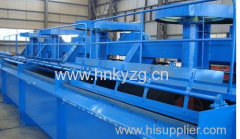
XJK type flotation machine
| Min. Order: | 1 Set/Sets |
|---|---|
| Payment Terms: | L/C, T/T |
| Place of Origin: | Henan |
Company Profile
| Location: | Zhengzhou, Henan, China (Mainland) |
|---|---|
| Business Type: | Manufacturer |
Product Detail
| Model No.: | all models |
|---|---|
| Means of Transport: | Ocean |
| Packing: | negotiable |
| Delivery Date: | within 15 days |
Product Description
The flotation machine can be effectively applied for applications involving the separation of ferrous and non ferrous metal such as fluorite and talc. The machine has an impeller which works to create centrifugal forces in the form of negative pressure.
The machine impellers and stators should be kept at a distance and replacement done as soon as they get worn. The pump bearings should be maintained every three months.
Features
The flotation machine consumes little amounts of energy while at the same time maintaining a high air-absorption rate capacity. The machine is made up of individual cells which independently form a flotation separation loop without the need for any auxiliary equipment. They all are designed to carry out the following functions: air absorption, slurry absorption and flotation separation. Each of the cells is located horizontally to facilitate the easy change of flow. The mineral slurry circulates at a reasonable rate and the disposition of coarse sand is largely avoided. A self-control device is located on the surface of the mineral slurry facilitating easy adjustment of the level. There are two types of vanes found in the impeller: backward-inclined upper vanes and lower vanes, for upper and lower circulation of mineral slurry
Working Theory
When in application, the impeller is revolved by the motor in order to produce centrifugal forces and negative pressure. Air is then absorbed to mix with the ore pulp (slurry). The ore pulp is stirred and mixed with chemical additives, which results in the formation of mineralized froth on the surface of the slurry. The liquid level can be carefully adjusted by altering the height of the flash board (strobe) to facilitate the scraping of the mineralized form (froth) to the launder using a squeegee.
Specifications of Flotation Machine
Type | Cubage(m3) | Diameter of impellor(mm) | Capacity (m3/min) | Speed of impellor(r/min) | Motor of impellor | Weight |
XJK-0.13 | 0.13 | 200 | 0.05-0.16 | 600 | Y90L-4-1.5 | 0.23 |
XJK-0.23 | 0.23 | 250 | 0.12-0.28 | 500 | Y90L-4-1.5 | 0.35 |
XJK-0.35 | 0.35 | 300 | 0.18-0.4 | 470 | Y90L-4-1.5 | 0.43 |
XJK-0.62 | 0.62 | 350 | 0.3-0.9 | 400 | Y100L-4-3 | 0.86 |
XJK-1.1 | 1.1 | 500 | 0.6-1.6 | 330 | Y100M-4-5.5 | 1.38 |
XJK-2.8 | 2.8 | 600 | 1.5-3.5 | 280 | Y100M-4-11 | 2.33 |
XJK-5.8 | 1.1 | 750 | 3-7 | 240 | Y100M-4-22 | 3.533 |







